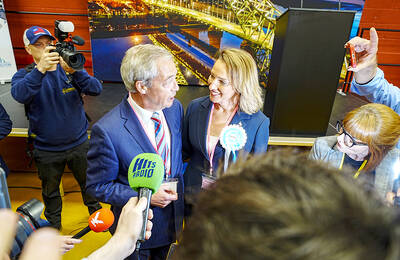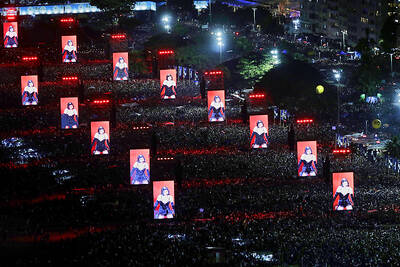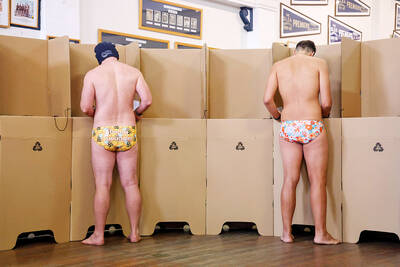Despite decades of denials by Washington and Tokyo, US officials believe they enjoyed a secret pact to transport nuclear weapons through Japan, newly declassified documents showed.
The disclosure came after Japan’s left-leaning government ended more than half a century of conservative rule and launched a probe into thousands of files to settle longstanding suspicions of a hush-hush pact.
Any evidence of an agreement would trigger charges of hypocrisy as Japan is the only nation to have suffered nuclear attacks and has campaigned for the worldwide abolition of the ultra-destructive weapons.
The National Security Archive at George Washington University released documents on Tuesday showing that US officials believed they had an understanding with Japan when the allies signed a new security treaty in 1960.
A confidential US State Department memo prepared in 1960 for then secretary of state Christian Herter to brief Congress said Washington had to consult Japan on “introduction of nuclear weapons.”
However, it said that the US, which has stationed troops in Japan since its defeat in World War II, could use Japanese soil “as needed” in an emergency if communist neighbor North Korea launched an attack.
In a cable sent in 1963, then-US ambassador to Japan Edwin Reischauer said he quietly met for breakfast with the foreign minister, Masayoshi Ohira, and sensed a “full understanding” on the nuclear issue.
“Ohira took [the] presentation in stride and showed not rpt [repeat] not [the] slightest desire to persuade us to alter [the] standing practice,” the cable said.
Whatever the sensitivity of nuclear weapons in Japan, the issue largely involves past history. In 1991 as the Cold War ended, then-president George H.W. Bush stopped US vessels from carrying tactical nuclear weapons.
However, both the US and Japan’s previous governments have steadfastly rejected an inquiry, with Washington saying its military policy is never to confirm or deny the presence of nuclear weapons.
“In terms of nuclear weapons, there has always been a resistance to releasing information, particularly where they are based,” said Robert Wampler, a senior fellow at the National Security Archive who led the study.
“But here we are talking about Cold War agreements — dealing with Korea, Vietnam, the Soviets and China,” Wampler said, pleading for the release of more documents.
“It’s secret in name only and I think it would be really great if the Japanese government would clear the air,” he said.
However, any investigation could also get bogged down in semantics on what the US and Japan agreed to.
One declassified 1960 document presented to the secretary of state said in typeface that there was a “confidential agreement.”
The word “agreement” was crossed off with a pen and replaced with “understanding.”
The declassified material also said that US negotiators stressed that they would not “introduce” nuclear weapons to Japan — drawing a distinction with transiting the arms.
The documents provide no clear smoking-gun on one persistent suspicion — that then-US president Richard Nixon insisted on the nuclear transit rights when handing the southern island chain to Okinawa back to Japan in 1972.
However, a 1969 memo by Henry Kissinger, then the national security adviser, detailed Nixon’s negotiating strategy — saying he would press until the last minute to keep US nuclear weapons in Okinawa and was ready to drop the demand in exchange for the transit rights.
Nixon negotiated the handover with Japanese prime minister Eisaku Sato, who later won the Nobel Peace Prize largely for his so-called “three principles” — that Japan will not possess, produce or allow nuclear weapons on its soil.
The US dropped atom bombs on Hiroshima and Nagasaki in 1945, killing more than 210,000 people and ending World War II.

Kehinde Sanni spends his days smoothing out dents and repainting scratched bumpers in a modest autobody shop in Lagos. He has never left Nigeria, yet he speaks glowingly of Burkina Faso military leader Ibrahim Traore. “Nigeria needs someone like Ibrahim Traore of Burkina Faso. He is doing well for his country,” Sanni said. His admiration is shaped by a steady stream of viral videos, memes and social media posts — many misleading or outright false — portraying Traore as a fearless reformer who defied Western powers and reclaimed his country’s dignity. The Burkinabe strongman swept into power following a coup in September 2022

‘FRAGMENTING’: British politics have for a long time been dominated by the Labor Party and the Tories, but polls suggest that Reform now poses a significant challenge Hard-right upstarts Reform UK snatched a parliamentary seat from British Prime Minister Keir Starmer’s Labor Party yesterday in local elections that dealt a blow to the UK’s two establishment parties. Reform, led by anti-immigrant firebrand Nigel Farage, won the by-election in Runcorn and Helsby in northwest England by just six votes, as it picked up gains in other localities, including one mayoralty. The group’s strong showing continues momentum it built up at last year’s general election and appears to confirm a trend that the UK is entering an era of multi-party politics. “For the movement, for the party it’s a very, very big

ENTERTAINMENT: Rio officials have a history of organizing massive concerts on Copacabana Beach, with Madonna’s show drawing about 1.6 million fans last year Lady Gaga on Saturday night gave a free concert in front of 2 million fans who poured onto Copacabana Beach in Rio de Janeiro for the biggest show of her career. “Tonight, we’re making history... Thank you for making history with me,” Lady Gaga told a screaming crowd. The Mother Monster, as she is known, started the show at about 10:10pm local time with her 2011 song Bloody Mary. Cries of joy rose from the tightly packed fans who sang and danced shoulder-to-shoulder on the vast stretch of sand. Concert organizers said 2.1 million people attended the show. Lady Gaga

SUPPORT: The Australian prime minister promised to back Kyiv against Russia’s invasion, saying: ‘That’s my government’s position. It was yesterday. It still is’ Left-leaning Australian Prime Minister Anthony Albanese yesterday basked in his landslide election win, promising a “disciplined, orderly” government to confront cost-of-living pain and tariff turmoil. People clapped as the 62-year-old and his fiancee, Jodie Haydon, who visited his old inner Sydney haunt, Cafe Italia, surrounded by a crowd of jostling photographers and journalists. Albanese’s Labor Party is on course to win at least 83 seats in the 150-member parliament, partial results showed. Opposition leader Peter Dutton’s conservative Liberal-National coalition had just 38 seats, and other parties 12. Another 17 seats were still in doubt. “We will be a disciplined, orderly